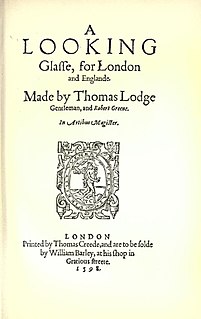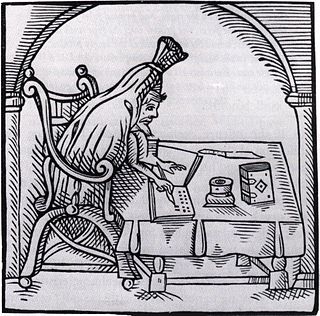Related Research Articles

The Winter's Tale is a play by William Shakespeare originally published in the First Folio of 1623. Although it was grouped among the comedies, many modern editors have relabelled the play as one of Shakespeare's late romances. Some critics consider it to be one of Shakespeare's "problem plays" because the first three acts are filled with intense psychological drama, while the last two acts are comic and supply a happy ending.
This article contains information about the literary events and publications of 1586.

Thomas Lodge, the son of Lord Mayor of London, Thomas Lodge, was an English writer and author during the Elizabethan and Jacobean periods.
George Peele was an English translator, poet, and dramatist, who is most noted for his supposed but not universally accepted collaboration with William Shakespeare on the play Titus Andronicus. Many anonymous Elizabethan plays have been attributed to him, but his reputation rests mainly on Edward I, The Old Wives' Tale, The Battle of Alcazar, The Arraignment of Paris, and David and Bethsabe. The Troublesome Reign of John, King of England, the immediate source for Shakespeare's King John, has been published under his name.

Locrine is an Elizabethan play depicting the legendary Trojan founders of the nation of England and of Troynovant (London). The play presents a cluster of complex and unresolved problems for scholars of English Renaissance theatre.
Thomas Underdown, also spelled Underdowne, was a translator. He translated the Æthiopian History of Heliodorus in 1569, and the Ibis of Ovid (1577). The Æthiopian History has been called "the ancestor in a direct line of the Novel of Adventure," and praised for anticipating every artifice of the historical novel.

"The King and the Beggar-maid" is a 16th-century broadside ballad that tells the story of an African king, Cophetua, and his love for the beggar Penelophon. The story has been widely referenced and King Cophetua has become a byword for "a man who falls in love with a woman instantly and proposes marriage immediately".
Fair Em, the Miller's Daughter of Manchester, is an Elizabethan-era stage play, a comedy written c. 1590. It was bound together with Mucedorus and The Merry Devil of Edmonton in a volume labelled "Shakespeare. Vol. I" in the library of Charles II. Though scholarly opinion generally does not accept the attribution to William Shakespeare, there are a few who believe they see Shakespeare's hand in this play.
Alexander Cooke was an actor in the King's Men and the Lord Chamberlain's Men, the acting companies of William Shakespeare, John Heminges and Richard Burbage.

Friar Bacon and Friar Bungay, originally entitled The Honorable Historie of Frier Bacon and Frier Bongay, is an Elizabethan era stage play, a comedy written by Robert Greene. Widely regarded as Greene's best and most significant play, it has received more critical attention than any other of Greene's dramas.

Perdita is one of the heroines of William Shakespeare's play The Winter's Tale. She is the daughter of Leontes, King of Sicilia, and his wife Hermione.

Robert Greene (1558–1592) was an English author popular in his day, and now best known for a posthumous pamphlet attributed to him, Greene's Groats-Worth of Witte, bought with a million of Repentance, widely believed to contain an attack on William Shakespeare. Robert Greene was a popular Elizabethan dramatist and pamphleteer known for his negative critiques of his colleagues. He is said to have been born in Norwich. He attended Cambridge where he received a BA in 1580, and an M.A. in 1583 before moving to London, where he arguably became the first professional author in England. Greene was prolific and published in many genres including romances, plays and autobiography.
Cuthbert Burby was a London bookseller and publisher of the Elizabethan and early Jacobean eras. He is known for publishing a series of significant volumes of English Renaissance drama, including works by William Shakespeare, Robert Greene, John Lyly, and Thomas Nashe.
The Thracian Wonder is a stage play of English Renaissance drama, a work that constitutes a long-standing and persistent problem for scholars and historians of the subject.

Will Shakespeare, also known as Life of Shakespeare and William Shakespeare: His Life & Times, was a 1978 historical drama series created and written by John Mortimer. Broadcast in six parts, the series is a dramatisation of the life and times of the great poet William Shakespeare, played by Tim Curry, and was co-produced by Lew Grade's ATV and RAI and distributed internationally by ITC. The two production companies had collaborated successfully the previous year on Jesus of Nazareth.
Nationality words link to articles with information on the nation's poetry or literature.
Francis Sabie was an English poet.
The Winter's Tale is a ballet in three acts choreographed by Christopher Wheeldon to a commissioned score by Joby Talbot. The ballet is based on the play of the same name by William Shakespeare. With scenery and costumes designed by Bob Crowley, lighting designed by Natasha Katz, and special stage effects designed by Daniel Brodie and Basil Twist, it was a co-production of the Royal Ballet and the National Ballet of Canada. It was first presented at the Royal Opera House, London, on 10 April 2014. The North American premiere occurred the following year.

The Winter's Tale is a 1910 American silent short drama produced by the Thanhouser Company. The plot is an adaptation of The Winter's Tale by William Shakespeare and requires fore-knowledge of the plot in order to understand the condensed one reel work. The film focuses on the conflict arising from two Kings, one of Bohemia and one of Sicily, during a meeting. Queen Hermione enrages her jealous husband, Leontes, by entertaining Polixenes. Leontes decides to kill him with poison, but the plan is foiled by the courtier tasked with the assassination. For this, Leontes imprisons his wife. Hermione gives birth to a daughter and Leontes orders the baby to die out in the wilderness. Hermione is then brought before the court and apparently dies after interrogation. Fifteen years pass and Polixenes confronts and then secretly follows his son, appearing as he declares his intention to marry a shepherdess. The two lovers seek protection with Leontes, the King of Sicilia. Mourning and repentant for his past actions, Leontes learns the shepherdess is his daughter and blesses the marriage of the lovers. The royal party goes to see a statue of the late queen Hermoine which is revealed to be alive. The cast includes Anna Rosemond, Frank H. Crane and Martin Faust, but the directorial and production credits for the film are unknown. The production was a success for the Thanhouser Company and the film was met with positive reception following its May 27, 1910 release. The film survives in the Library of Congress, but it is missing the final scene of the production. The surviving print suffers from significant deterioration.
Sir Edward Wingfield of Kimbolton (c.1562-1603), member of Parliament and author of a masque.
References
- ↑ Literary Encyclopedia entry for Pandosto
- 1 2 Sidney, Lee (1897). . In Lee, Sidney (ed.). Dictionary of National Biography . 50. London: Smith, Elder & Co.
sources: [Collier's Bibl. Cat. ii. 2, 305–7; Collier's Poet. Decameron, i. 137-41; information kindly supplied by R. E. Graves, esq.]
- ↑ Thomas H. McNeal, "The Clerk's Tale as a Possible Source for Pandosto," Papers of the Modern Language Association Vol. 47 No. 2 (June 1932), pp. 453-60.
- ↑ Edward Chaney, The Evolution of the Grand Tour: Anglo-Italian Cultural Relations since the Renaissance,(Routledge, 2000) p. 12.
- ↑ F. E. Halliday, A Shakespeare Companion 1564–1964, Baltimore, Penguin, 1964; pp. 328, 352.
